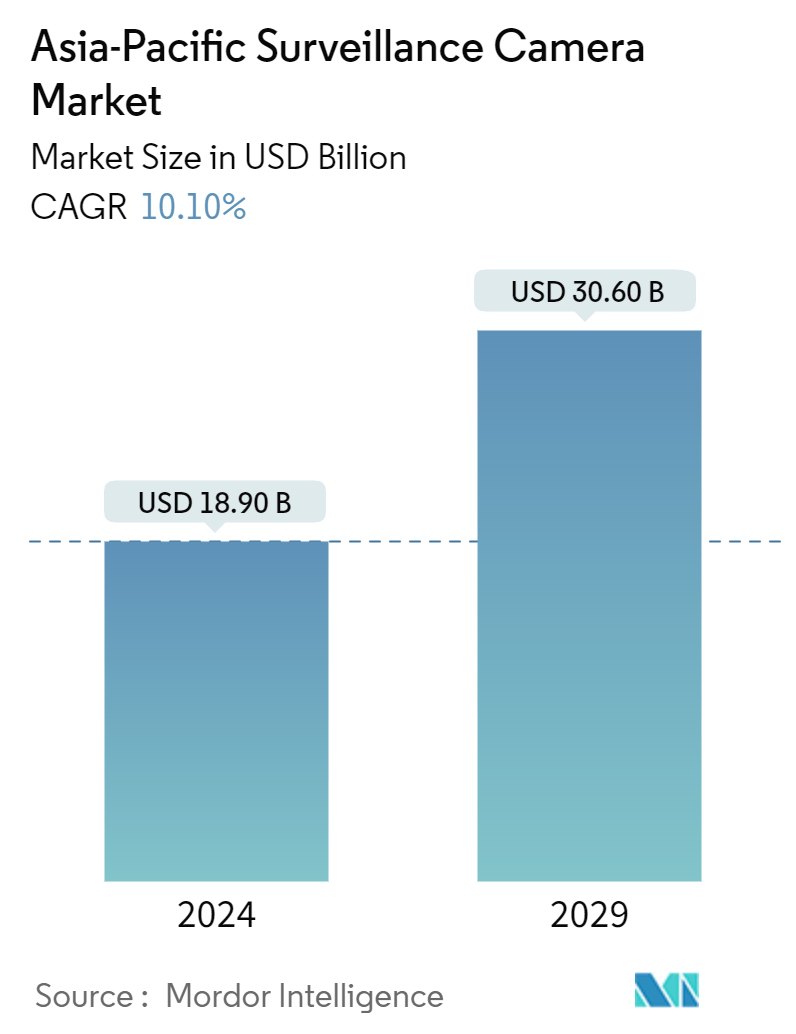Market Size of Asia-Pacific Surveillance Camera Industry

| Study Period | 2019 - 2029 |
| Base Year For Estimation | 2023 |
| Market Size (2024) | USD 18.90 Billion |
| Market Size (2029) | USD 30.60 Billion |
| CAGR (2024 - 2029) | 10.10 % |
| Market Concentration | Low |
Major Players
*Disclaimer: Major Players sorted in no particular order |
Asia-Pacific Surveillance Camera Market Analysis
The Asia-Pacific Surveillance Camera Market size is estimated at USD 18.90 billion in 2024, and is expected to reach USD 30.60 billion by 2029, growing at a CAGR of 10.10% during the forecast period (2024-2029).
In the past, video surveillance cameras were primarily used for security purposes. However, they are increasingly being utilized to improve the performance of businesses. Companies are searching for AI-compatible video surveillance systems capable of providing valuable insights from the data collected. These systems offer advanced features such as the ability to automatically detect and send real-time alerts regarding security risks and collect data to provide insights such as peak customer throughput or wait times. With the corporate sector growing significantly in Asia-Pacific, the demand for such solutions is also witnessing notable growth.
Asia-Pacific is poised for a surge in demand for surveillance cameras, driven by the robust growth potential of its end-user industries. Notably, as countries like India and China witness a rapid expansion in industrial infrastructure, the need for surveillance cameras for asset tracking and ensuring workplace safety is on the rise. Moreover, heightened crime rates in several nations are prompting increased investments by government and public authorities in advanced surveillance technologies, further bolstering the market's outlook.
Surveillance cameras in the region find extensive applications, spanning public spaces, infrastructure, and commercial establishments. With advancements like AI integration, the capabilities of video surveillance systems are broadening. For instance, in June 2023, Dahua Technology's AI cameras in China successfully alerted authorities when banners were raised, showcasing the increasing adoption of AI in governmental monitoring.
The convergence of big data, IoT, and deep learning algorithms is paving the way for AI-driven video surveillance. Highlighting this, in May 2024, more than 50 housing board projects in an Asian city embraced live video surveillance, empowered by cutting-edge AI. This AI not only proactively identified and flagged potential hazards during construction but also seamlessly integrated with existing CCTV setups, enhancing real-time hazard detection.
Such advancements are prompting public authorities to ramp up their investments in surveillance systems. A case in point is the Maharashtrian government's approval in January 2024 for installing over 6,000 CCTV cameras in Thane City, Mumbai. Additionally, the Thane police initiated the "Har Ghar Camera" campaign to further promote the adoption of surveillance cameras.
Yet, challenges loom, particularly concerning privacy and data protection compliance. The implementation of surveillance systems must navigate a complex web of laws and regulations, emphasizing the need for stringent privacy safeguards. Misuse of such technology can exacerbate privacy concerns, posing hurdles to the market's growth in Asia-Pacific.
The COVID-19 pandemic disrupted the supply chain and manufacturing of surveillance cameras, notably affecting major suppliers like China. However, with most pandemic restrictions lifted, the market is witnessing a resurgence, fueled by heightened demand from both residential and commercial sectors. Notably, luxury home sales in India surged by 130% in the first half of 2023, underlining the growing emphasis on security and surveillance systems in upscale housing properties, further bolstering the market's trajectory.
Asia-Pacific Surveillance Camera Industry Segmentation
Surveillance cameras are gaining popularity for their cost-effectiveness and user-friendly nature. This surge has seen a rise in installations across residential and commercial spaces, all aimed at enhancing security. Thanks to technological advancements, these cameras are reshaping the security landscape. They come in a variety of styles and resolutions, tailored for different needs, including indoor, outdoor, box, dome, bullet, IP, day and night, wireless, thermal imaging, PTZ, and beyond. The market is defined by the revenue accrued from the sales of different types of surveillance cameras over various end users across Asia-Pacific.
The Asia-Pacific surveillance camera market is segmented by type (analog-based, IP-based, and hybrid), end-user industry (government, banking, healthcare, transportation and logistics, industrial, and other end-user industries [educational institutions, retail, and enterprise]), and country (China, Japan, India, and Rest of Asia-Pacific). The market sizes and forecasts are provided in terms of value (USD) for all the above segments.
| By Type | |
| Analog-based | |
| IP-based | |
| Hybrid |
| By End-user Industry | |
| Government | |
| Banking | |
| Healthcare | |
| Transportation and Logistics | |
| Industrial | |
| Other End-user Industries (Education Institutions, Retail, and Enterprises) |
| By Country*** | |
| China | |
| Japan | |
| India |
Asia-Pacific Surveillance Camera Market Size Summary
The Asia-Pacific surveillance camera market is experiencing significant growth, driven by the increasing demand for advanced security solutions across various sectors. Initially focused on security, surveillance cameras are now being leveraged to enhance business performance through AI-compatible systems that provide real-time insights and alerts. The rapid expansion of industrial infrastructure in countries like India and China, coupled with rising crime rates, is fueling the demand for these technologies. Public authorities are investing heavily in surveillance systems to ensure safety and security, further propelling market growth. The integration of AI, big data, and IoT is transforming surveillance capabilities, with applications extending to public spaces, infrastructure, and commercial establishments.
The market is characterized by a competitive landscape with numerous local and global players, leading to a fragmented market structure. Companies are adopting strategies such as product innovation, partnerships, and mergers to strengthen their market presence. Digital and IP-based cameras are gaining traction due to their superior features, including high-definition video capture and remote monitoring capabilities. The COVID-19 pandemic initially disrupted supply chains, but the market is rebounding as demand from residential and commercial sectors rises. Notable advancements, such as AI-driven surveillance systems and cloud-based solutions, are reshaping the market dynamics, with major players like Hikvision, Dahua Technology, and Hanwha Vision leading the charge.
Asia-Pacific Surveillance Camera Market Size - Table of Contents
-
1. MARKET INSIGHTS
-
1.1 Market Overview
-
1.2 Industry Attractiveness - Porter's Five Forces Analysis
-
1.2.1 Bargaining Power of Suppliers
-
1.2.2 Bargaining Power of Consumers
-
1.2.3 Threat of New Entrants
-
1.2.4 Threat of Substitutes
-
1.2.5 Intensity of Competitive Rivalry
-
-
1.3 Impact of COVID-19 Aftereffects and Other Macroeconomic Factors on the Market
-
-
2. MARKET SEGMENTATION
-
2.1 By Type
-
2.1.1 Analog-based
-
2.1.2 IP-based
-
2.1.3 Hybrid
-
-
2.2 By End-user Industry
-
2.2.1 Government
-
2.2.2 Banking
-
2.2.3 Healthcare
-
2.2.4 Transportation and Logistics
-
2.2.5 Industrial
-
2.2.6 Other End-user Industries (Education Institutions, Retail, and Enterprises)
-
-
2.3 By Country***
-
2.3.1 China
-
2.3.2 Japan
-
2.3.3 India
-
-
Asia-Pacific Surveillance Camera Market Size FAQs
How big is the Asia-Pacific Surveillance Camera Market?
The Asia-Pacific Surveillance Camera Market size is expected to reach USD 18.90 billion in 2024 and grow at a CAGR of 10.10% to reach USD 30.60 billion by 2029.
What is the current Asia-Pacific Surveillance Camera Market size?
In 2024, the Asia-Pacific Surveillance Camera Market size is expected to reach USD 18.90 billion.

